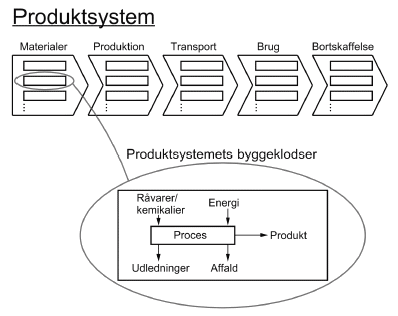EDIPTEX - Environmental assessment of textiles
3 Unit processes - the building blocks of the product system
The environmental impacts of a product occur in the processes that make up the lifecycle. The entire lifecycle of the product is also called the product system. The phases of the lifecycle: materials, production, transport, use and disposal each consist of a number of processes that could also be called the building blocks of the product system.

Figure 3.1. The product system and its building blocks (processes) – for translation of Danish terms see glossary in annex 11
When the building block is quantified, it is called a unit process. This means that data is processed and related to a specific volume of the product from the process in question. This makes the data scalable and thus generally applicable in various contexts of environmental assessment.

Figure 3.2 building block is related to a specific volume and is designated "unit process" – for translation of Danish terms see glossary in annex 11
3.1 Brief description of the EDIP assessment method
A specific procedure is followed when a product is environmentally assessed. Internationally[1], it has been agreed that an environmental assessment must follow the steps briefly described below.
Objective
In this step, the purpose of the environmental assessment is described, as well as the recipient(s) and the decisions it is intended to support.
Delimitation
In this step, the product to be assessed is described, the product's performance is stated, and it the amount included in the assessment is defined. In order to ensure that the same performance is assessed every time, the performance is defined in relation to the volume and quality of the performance. This is called the functional unit. Crucial for the results of the environmental assessment is that the functional unit is defined correctly and precisely. This step also includes parameters like time, geography and technology. For example, it should be determined whether modern or older production methods are used, where the product is sold, etc.
Statement
In this step, data from all the processes of the product's lifecycle are collected and processed, i.e. from cradle to grave. These data will be used to calculate consumption and discharges from all processes of the product's lifecycle. The EDIP method applies a bill of materials as the structure for the product, and materials content and production processes are specified in detail.
Data is processed and stored for the unit processes. The data format in the EDIP database for unit processes contains three categories of information:
- description of the process
- statement of the interchange with the environment (input and output), and
- a description of the data information.
The EDIP unit process database contains a possibility for correcting or establishing new data descriptions when necessary. Collecting and processing data can be a very time-consuming task.
The assessment
When the statement is complete, it must be assessed. The first step of the assessment is a translation of data to the environmental impacts expected from the individual discharges and emissions. This translation is called characterisation, and environmental impact potentials are worked out.
Environmental impacts, resource consumption and impacts on occupational health and safety are assessed in the EDIP method. What is the resource consumption? How big are the environmental impacts? In order to be able to interpret resource consumption and expected environmental impacts, it is necessary to bring them on to a common scale and use the same comparison reference. This is called normalisation.
During normalisation, the size of the expected environmental impacts and resource consumption are expressed in a unit it is easy to relate to; i.e. fractions of the annual impact from an average person. It is expressed in the unit person-equivalents (PE), e.g. for an average person's impact in Denmark in 1990 and is written PE DK90, and for the world PEW90.
The EDIP PC tool supports this procedure, and the results can be shown as easy-to-read diagrams. Subsequently, uncertainty and sensitivity analyses of the results of the assessment are carried out.
The assessment also allows for interpretation of the results of the normalisation, i.e. for making mutual comparisons. This is called weighting. How serious are the expected environmental impacts or the demand on resources, and what is worse; contributions to the greenhouse effect or to acidification? Which impact types are global and which are regional, and what is important?
The mutual degree of importance of the environmental impacts is shown in a set of weighting factors that reflect the possible consequences of the environmental impacts in relation to each other. The weighting can be based on purely environmental parameters as critical threshold values and on more attitudinal parameters like politically set reduction goals for emissions, such as CO2 emissions.
The EDIP method is based on the existing goals for reduction of various types of environmental impacts expressed as the unit PEMWDK2000. This stands for person-equivalent for target or accepted emissions in 2000 globally, regionally as well as locally.
The weighting procedure is also carried out in the EDIP PC tool, and the results are illustrated in easy-to-read diagrams, just as for normalisation.
Interpretation
Further interpretation also includes an assessment of whether the results adequately meet the objective of the environmental assessment.
Footnotes
[1] ISO 14040 series
Version 1.0 July 2007, © Danish Environmental Protection Agency